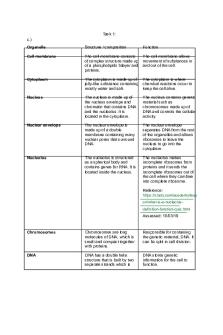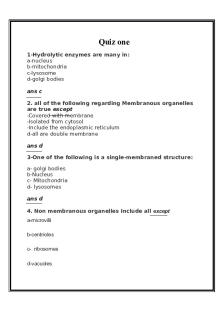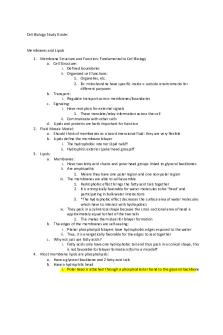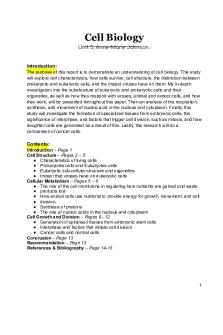MCQ ON CELL Biology PART II PDF

| Title | MCQ ON CELL Biology PART II |
|---|---|
| Author | xxx hjhjh |
| Course | Biotechnology |
| Institution | University of Mumbai |
| Pages | 5 |
| File Size | 81.2 KB |
| File Type | |
| Total Downloads | 27 |
| Total Views | 132 |
Summary
eee...
Description
MCQ ON CELL BIOLOGY PART II 1. The daughter cells that are formed when the septum forms near the poles of the cell is known as (a) daughter cell (b) macrocell (c) minicell (d) microcell Answer: (c) 2. _____________ is also used to address lag phase (a) generation time (b) transitional period (c) period of initial adjustment (d) none of the above Answer: (c) 3. This can best describe a microbial control protocol inhibiting the growth of molds and yeasts (a) fungistatic (b) bactericidal (c) fungicidal (d) bacteriostatic Answer: (a) 4. In gram-positive cells, during its reproduction, synthesis of new membrane material is carried out by this organelle (a) cytoplasmic membrane (b) endoplasmic reticulum (c) mesosome (d) nucleus Answer: (c)
5. A fold or bleb like formation is seen in this bacteria (a) E.coli (b) Bacillus subtilis (c) Rhodopseudomonas acidophila (d) Streptococcus faecalis Answer: (a) 6. This is not a characteristic of a growth curve (a) every growth curve has 4 distinct stages (b) Graph numbers of microbes versus time (c) plotted with logarithmic numbers (d) under relatively stable environmental conditions, development of microbial population is seen Answer: (a) 7. Spores produced endogenously are found in all except this (a) Rhizopus (b) Mushroom (c) Mucor (d) Albugo Answer: (b) 8. _____________ is used to refer to the growth of bacteria or microbes (a) increase in the number of cells (b) change in the total population (c) increase in the mass of an individual entity (d) increase in the size of an individual entity Answer: (a) 9. In bacteria, sporulation takes place in this growth phase (a) phase of decline
(b) log phase (c) lag phase (d) stationary phase Answer: (d) 10. Rhodopseudomonas acidophila follows this mode of reproduction (a) Budding (b) Sporulation (c) Fragmentation (d) Binary fission Answer: (a) 1. Endotoxin produced by gram negative bacteria is present in a. Peptidoglycan b. Lippolysacharide c. Theichoic acid d. Inner membrane 2. Which one of the following was Gram negative, chemolithotrophic bacteria? a. Siderococcus b. E.coli c. Spirellum d. Mycoplasms 3. Staining material of gram positive bacterium is a. Fast green b. Haematoxylon c. Crystal violet d. Safranin 4. Bacillus is an example of a. Gram positive bacteria b. Gram negative bacteria c. Virus d. Viroid 5. Mordant used in grams staining is a. Crystal violet b. Iodine c. Saffranin d. All of these 6. Gram staining is an example for a. Simple staining b. Differential staining c. Negative staining d. None of these 7. Cell wall of gram negative bacteria (is) a. Thick b. Lipids are present c. Teichoic acids are absent d. None of these
8. The differences between Gram positive and Gram negative bacteria is shown to reside in the a. Cell wall b. Nucleus c. Cell membrane d. Mesosomes 9. All the groups of bacteria have cell wall a. Mycobacteria b. Mycoplasmas c. Clostridia d. Rickettsia 10. Thickness of cell wall ranges from a. 9-10 nm b. 12-13 nm c. 10-25 nm d. 30-40 nm 11. Teichoic acids and Teichuronic acids are found in a. Gram positive bacteria b. Gram negative bacteria c. Fungi d. None of these 12. The cell wall deficient form of bacteria is a. Mycoplasma b. ‘L’ form c. Protoplast d. Spheroplast 13. The action of alcohol during Gram staining is a. Allows the color b. It adds color c. Decolorises the cells d. None of these 14. Lipid contents is more in a. Gram negative bacteria b. Gram positive bacteria c. Same in both d. None of these 15. Bacterial spores are a. Weakly acid fast c. Alcohol fast
b. Strongly acid fast d. Non acid fast
16. Endospores can be stained with a. Safranine b. Crystal violet c. Methylene blue d. Malachite green 17. Cell-wall is a. Thick in Gram positive than Gram negative b. Thick in Gram negative than Gram positive c. Equal in both d. In Gram negative cell-wall is absent 18. The Lipid content present in Gram positive bacterial cell-wall is a. 1-10 % b. 1-5 % c. 2-8 % d. None of these 19. The order of stains in Gram-staining procedure is
a. Crystal violet, Iodine solution, Alcohol, Saffranine b. Iodine solution, Crystal Violet, Saffranine, Alcohol c. Alcohol, Crystal Violet, Iodine solution, Saffranine d. All of these 20. The percentage of alcohol used in Gram staining is a. 75% b. 90% c. 60% d. 25% 21. Gram positive bacteria appear as a. Pink b. Violet c. both a & b d. None of these 22. Gram negative bacteria appear as a. Pink b. Violet c. both a & b d. None of these 23. If only one stain is used for staining a specimen a. Simple staining b. Negative staining c. Differential staining d. None of these 24. If more than one stain is used, such staining is called a. Simple staining b. Negative staining c. Differential staining d. None of these...
Similar Free PDFs

MCQ ON CELL Biology PART II
- 5 Pages

Molecular cell biology Part A
- 83 Pages

Cell biology
- 3 Pages

Cell Biology Quiz CELL ORGANELLES
- 10 Pages

Cell Signaling MCQ
- 6 Pages

Mcq - MCQ ON AFM
- 31 Pages

Cell Biology Study Guide
- 37 Pages

Cell Biology unit (5)
- 14 Pages

Cell Biology Syllabus 2019
- 5 Pages

Apoptosis - Summary Cell Biology
- 4 Pages

Cell biology exam, answers
- 11 Pages

Cell biology lecture notes
- 108 Pages

Adam\'s Cell Biology- Exocytosis
- 4 Pages

Cell biology and genetics
- 12 Pages

Cell biology revision notes
- 5 Pages
Popular Institutions
- Tinajero National High School - Annex
- Politeknik Caltex Riau
- Yokohama City University
- SGT University
- University of Al-Qadisiyah
- Divine Word College of Vigan
- Techniek College Rotterdam
- Universidade de Santiago
- Universiti Teknologi MARA Cawangan Johor Kampus Pasir Gudang
- Poltekkes Kemenkes Yogyakarta
- Baguio City National High School
- Colegio san marcos
- preparatoria uno
- Centro de Bachillerato Tecnológico Industrial y de Servicios No. 107
- Dalian Maritime University
- Quang Trung Secondary School
- Colegio Tecnológico en Informática
- Corporación Regional de Educación Superior
- Grupo CEDVA
- Dar Al Uloom University
- Centro de Estudios Preuniversitarios de la Universidad Nacional de Ingeniería
- 上智大学
- Aakash International School, Nuna Majara
- San Felipe Neri Catholic School
- Kang Chiao International School - New Taipei City
- Misamis Occidental National High School
- Institución Educativa Escuela Normal Juan Ladrilleros
- Kolehiyo ng Pantukan
- Batanes State College
- Instituto Continental
- Sekolah Menengah Kejuruan Kesehatan Kaltara (Tarakan)
- Colegio de La Inmaculada Concepcion - Cebu
